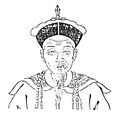Viceroy of Liangjiang facts for kids
Quick facts for kids Viceroy of Liangjiang |
|||||||
|---|---|---|---|---|---|---|---|
| Chinese name | |||||||
| Traditional Chinese | 兩江總督 | ||||||
| Simplified Chinese | 两江总督 | ||||||
|
|||||||
| Governor-General of the Two River Provinces and Other Local Admirals, in Charge of Military Affairs, Food and Wages, Management of Rivers, and Administration on Nanhe Affairs (full title) |
|||||||
| Traditional Chinese | 總督兩江等處地方提督軍務、糧饟、操江、統轄南河事務 | ||||||
| Simplified Chinese | 总督两江等处地方提督军务、粮饷、操江、统辖南河事务 | ||||||
|
|||||||
| Manchu name | |||||||
| Manchu script | ᡤᡳᠶᠠᠩᠨᠠᠨ ᡤᡳᠶᠠᠩᠰᡳ ᡠᡥᡝᡵᡳ ᡴᠠᡩᠠᠯᠠᡵᠠ ᠠᠮᠪᠠᠨ |
||||||
| Romanization | giyangnan giyangsi uheri kadalara amban | ||||||
The Viceroy of Liangjiang was a very important job in China during the Qing dynasty. This person was like a super-governor for a large area. Their full Chinese name meant "Governor-General of the Two River Provinces and Other Local Admirals, in Charge of Military Affairs, Food and Wages, Management of Rivers, and Administration on Nanhe Affairs."
The Viceroy of Liangjiang was one of eight main regional leaders during that time. They were in charge of military, government, and daily life for the areas of Jiangnan and Jiangxi. Jiangnan is now parts of Jiangsu, Anhui, and Shanghai. Jiangxi is mostly the modern-day Jiangxi province. This important role started in 1647 and ended in 1912.
Contents
History of the Viceroy Role
The job of Viceroy of Liangjiang began in 1647. This was during the rule of the Shunzhi Emperor. At first, it was called "Viceroy of the Three Provinces of Jiangdong, Jiangxi, and Henan." The main office was in Jiangning, which is now Nanjing.
A few years later, in 1652, the name changed to "Viceroy of Jiangxi." The office moved to Nanchang for a short time. But soon, the old system and name came back.
Changes Under the Kangxi Emperor
During the time of the Kangxi Emperor, new Viceroy jobs were made for Jiangdong and Jiangxi in 1661 and 1674. However, these separate roles were later combined back into the Viceroy of Liangjiang in 1665 and 1682. From then on, the name "Viceroy of Liangjiang" stayed the same.
New Responsibilities
In 1723, the Yongzheng Emperor gave the Viceroy of Liangjiang even more power. The Viceroy also became the Secretary of War. This meant they helped manage the military. They also became a "Right Censor-in-Chief," which was like a chief inspector making sure officials were doing their jobs right.
Later, in 1831, the Daoguang Emperor added another big task. The Viceroy of Liangjiang became responsible for the salt trade in the Huai River area. Salt was a very important product back then!
Challenges During the Taiping Rebellion
During the Taiping Rebellion, a big uprising, the rebels took over Jiangning. They made it their capital city. Because of this, the Viceroy of Liangjiang's office had to move many times. It shifted to places like Yangzhou, Changzhou, Shanghai, Suzhou, and Anqing.
Trade and Commerce
In 1866, under the Tongzhi Emperor, the Viceroy of Liangjiang got more duties. They were put in charge of trade in the five treaty ports. These were special ports where foreign countries were allowed to trade. The Viceroy also became the "Southern Ocean Trade Minister." This was a very important role for managing international trade. The "Northern Ocean Trade Minister" was a similar role held by the Viceroy of Zhili.
End of an Era
The Qing dynasty ended in 1912. After that, the old headquarters of the Viceroy of Liangjiang in Nanjing became the Presidential Palace. This was the home of the President of the new Republic of China until 1949.
Images for kids

































